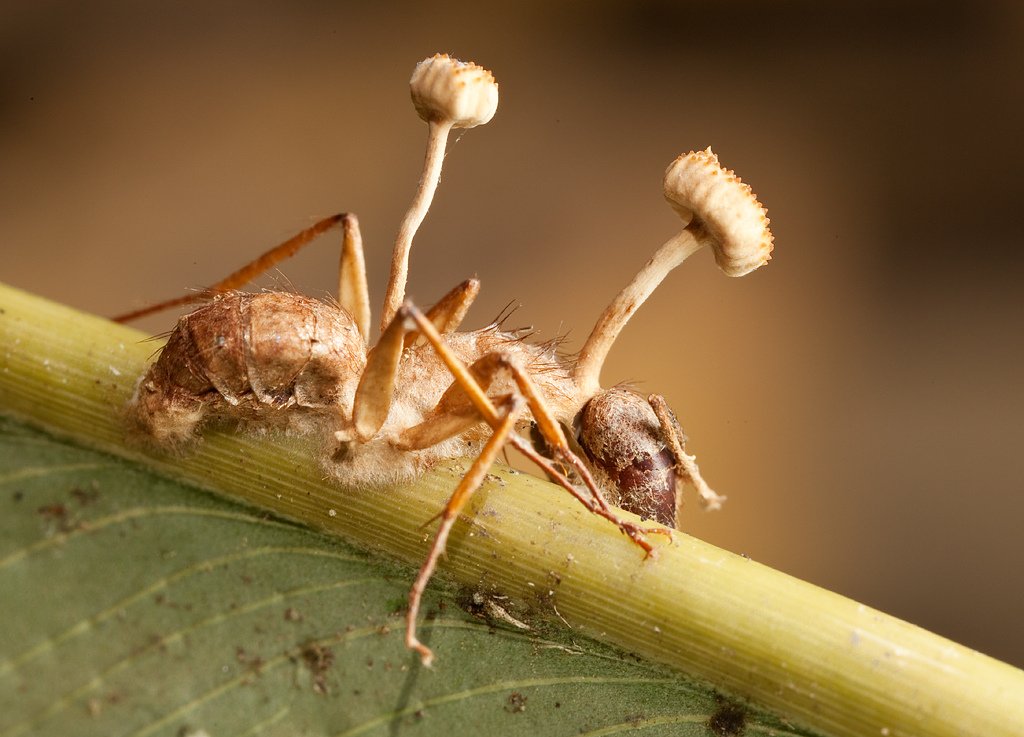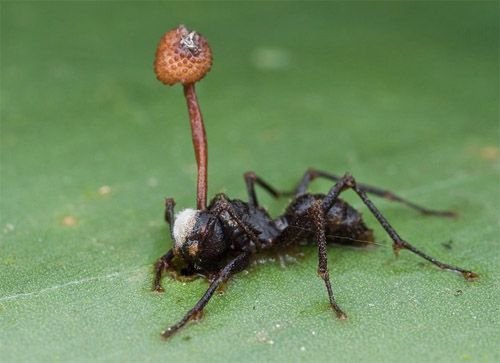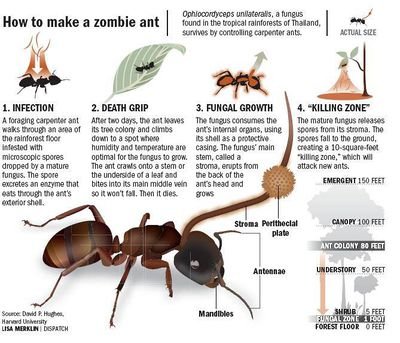I know, I promised to post a new strange animal each and every day. But today I will break that promise. Instead I will post something a bit different. Allow me to introduce you to a very interesting and scary, brain-controlling fungi that I briefly mentioned on yesterday's post. A fungi that turns ants into zombie-like slaves..only to kill them a few days later! The horrifying fungi I am talking about is...
Ophiocordyceps unilateralis

(credit: Linden Gledhill )
Ophiocordyceps unilateralis is an entomopathogen (insect-pathogenising) fungus that is commonly known as the zombie fungus and that for a good reason! In the past it was classified as Cordyceps unilateralis, but recently was reclassified and assigned to a new genus. The species grows in the rainforests of Brazil and in tropical forest regions in Thailand.
Why is O. unilateralis called the zombie fungus?
The answer to this question lies within its' lifecycle. Let's take everything from the start...
Imagine you are an ant of the Camponotus leonardi species. Just a regular ant, on a regular day, minding your own business and doing your ant-things. Then at some point the wind drops some tiny gifts on your body. These gifts are the spores of O. unilateralis. The spores attach to your body and eventually break through your exoskeleton with the help of specialized enzymes. At this point, your days are numbered!
The fungus first attacks your non-vital soft tissues. Next, it starts spreading all over your body and now is when the real fun begins. You lose your consciousness and you enter a zombie-like state. You become a slave to your fungi overlord! This is thanks to certain compounds that affect your brain and ultimately your behavior from this moment forward.
In the little time you now have left, the fungus will force you to climb up the stem of a tall plant, to go to the underside of a leaf and you will use your mandibles to secure yourself in that position. Note: This bite (called the "the death grip") is very strong and leaves a characteristic, dumbbell-shaped mark on the plant.
Slave, you have now served your primary purpose. The fungi will continue growing inside you, destroying your vital tissues.. Soon enough you are dead... But the fungi is not done with you yet..

(Credit)
What happens next?
After the host is dead, O. unilateralis continues to grow inside the dead body, producing more and more mycelia (the vegetative part of a fungus) and eventually it produces fruiting bodies that sprout out of the host's head, like a not so beautiful flower! These fruiting bodies continue to develop and eventually start to release new gifts (spores). With the help of the wind and gravity some ants will be lucky enough to get a gift... And a new cycle will begin!
Each circle takes anywhere from 4 to 10 days.
Here's a cool infograph summarizing the cycle (credit: David. P Hughes, Harvard University [3]):
How exactly does this mind control work?
How exactly the fungus takes control of the ants still remainsa mystery. A study in 2014 [4] revealed that the fungi releases thousands of unique chemicals, most of which are completely unknown. Among those, are two known neuromodulators, guanobutyric acid (GBA) and sphingosine. Both of them have been reported to be involved in neurological disorders and were enriched when the fungus was grown in the presence of brains of its target species.
Here is a comment by Dr Bekker, first author of that study:
"There is no single compound that is produced that results in the exquisite control of ant behavior we observe. Rather, it is a mixture of different chemicals that we assume act in synergy. But whatever the precise blend and tempo of chemical secretion, it is impressive that these fungi seem to 'know' when they are beside the brain of their regular host and behave accordingly."
And here's another comment from co-author of the same study, David Hughes:
"This is one of the most complex examples of parasites controlling animal behavior because it is a microbe controlling an animal -- the one without the brain controls the one with the brain. By employing metabolomics and controlled laboratory infections, we can now begin to understand how the fungi pull off this impressive trick."

But Wait, There's More!!! Meet The anti-zombie-fungus-fungus!!!
Here's something interesting. Apparently, there is a yet-unidentified hyperparasite that parasitizes on O. unilateralis which parasitizes on the Camponotus leonardi. Funny what natures comes up with sometimes. This hyperparasite (term for parasites that parasitize on parasites) attacks the zombie fungus at the flowering stage, preventing the stalk from releasing its spores. According to a study by David Hughes, only 6.5 %of the spore-producing organs of the zombie-ant fungus remain viable after infection, greatly limiting the damage O. unilateralis would otherwise do. [5]
In the photo below you can see an ant infected with Ophiocordyceps unilateralis, which in turn has been infected with the unidentified parasite (Credit: David Hughes, Penn State University):

Video
Here's a video from my all-time favorite David Attenborough showing the fungi in action. Enjoy:
Some Other Quick Facts About O. unilateralis
- The species was discovered by the British naturalist Alfred Russel Wallace in 1859,
- An investigation through plant fossil databases by Dr David P Hughes, revealed similar bite-marks on a fossil leaf from the Messel Pit. The fossil was around 48 million years old. Apparently there is a long, long history of zombie ants!
- There are many reported cases of entire ant colonies exterminated by the fungi. To protect themselves, the ants often groom each other and carry infected members far away from their nest.
- The fungus can infect other, closely related to C. leonardi species. However, when doing so, the mind-control is limited and the reproductive success is much smaller.
References & Further Reading
Here are some more links if you want to learn more about this amazing organism:
- https://www.ncbi.nlm.nih.gov/pmc/articles/PMC3204140/
- https://en.wikipedia.org/wiki/Ophiocordyceps_unilateralis#cite_note-pmc-3204140-7
- http://bytesizebio.net/2011/06/22/zombie-science-roundup/
- http://news.psu.edu/story/323688/2014/08/22/research/zombie-ant-fungi-know-brains-their-hosts
- http://science.psu.edu/news-and-events/2012-news/Hughes4-2012
SteemSTEM
Please consider supporting the @steemstem project. SteemSTEM is a community driven project which seeks to promote well written/informative Science Technology Engineering and Mathematics postings on Steemit. Click here to join the chat and learn more! The steemstem project is run by @justtryme90, @lemouth and some other cool guys & gals :)
More Strange Animals To Come
I will be posting one new strange animal each and every day so if you enjoyed this post make sure to follow me and let's discover together some of the world's most strange and bizarre creatures! An upvote and resteem would be nice too :P In the meantime, you may enjoy reading about the Red Lipped Batfish, the helicopter-like Brazilian Treehopper and learn why the Naked Mole Rat is the world's strangest mammal!


